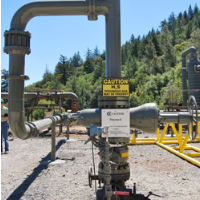State Shuts Down Fracking Waste Injection Sites as Possible Threats to Aquifers
 Fracking waste injection well (photo: Flickr-kqedquest)
Fracking waste injection well (photo: Flickr-kqedquest)
Two of California's most conspicuous environmental problems converged this month when state regulators shut down 11 fracking injection wells because of fear they may be contaminating aquifers in the Central Valley.
The Bakersfield Californian reported that the order from the Division of Oil, Gas and Geothermal Resources (DOGGR) came on July 7, just days before it was announced that 95 other wells were also being looked at. The wells, in Kern County, are used to inject waste water dredged up from oil and gas wells drilled using hydraulic fracturing techniques. The chemicals used in fracking are often unknown, protected by claims of trade secrets by the energy industry.
In 1982, the U.S. Environmental Protection Agency (EPA) allowed states to exempt aquifers deemed unsuitable for drinking and farming from well-drilling environmental restrictions. Critics claim the boundaries demarcating the safe and unsafe places to inject waste water back into the ground were vague and didn't provide adequate protection to water resources. The Californian said the state has about 42,000 injection wells, mostly in Kern County, and about 100 aquifers .
ProPublica reported that officials indicated at least seven of the 11 wells shut down were probably pumping waste water into clean aquifers. “The aquifers in question with respect to the orders that have been issued are not exempt,” Ed Wilson, a spokesperson for the California Department of Conservation, e-mailed the news organization. Two of the 11 wells have already reopened.
A ProPublica investigation in 2012 found that 700,000 injection wells across the country were poorly regulated and many were likely polluting aquifers. It found around 1,000 exempt aquifers, many of them in California.
The belated attention by the state to environmental threats posed by fracking, which has increased dramatically in recent years and is only now starting to be regulated, comes in the teeth of California's historically bad drought. Farmers, cut off from many of their usual supplies of surface water, are pumping groundwater at unsustainable rates.
State officials apparently discovered the suspect wells during a review of facilities required by Senate Bill 4, the fracking legislation passed last year. Fracking opponents have unsuccessfully sought a moratorium on fracking while the state draws up an environmental impact report and works on regulations to replace emergency rules passed at the end of 2013.
Critics say fracking has been linked to groundwater contamination, air pollution, releases of methane gas, micro-earthquakes and sink holes. They want full disclosure of fracking operations and sufficient public warning before drilling commences, at the very least.
The fight over fracking began to seriously heat up in California in 2011 when Governor Jerry Brown fired the acting director of the Department of Conservation and the head of DOGGR after the oil and gas industry complained that regulators were being too strict about enforcing U.S. fracking guidelines initiated in 2010.
After the officials were replaced, the backlog of inspections for fracking sites quickly disappeared as the state developed a more flexible approach to the permitting process, relying on historical records from worksites rather than new testing.
‒Ken Broder
To Learn More:
Oil Regulators Add 95 Wells to Review (by John Cox, Bakersfield Californian)
California Reviews Fracking Water Disposal Amid Contamination Concerns (by Rory Carroll, Reuters)
CA Halts Injection of Fracking Waste, Warning it May Be Contaminating Aquifers (by Abrahm Lustgarten, ProPublica)
State Poised to Shut Down 11 Local Oil Injection Wells (byJohn Cox, Bakersfield Californian)
- Top Stories
- Controversies
- Where is the Money Going?
- California and the Nation
- Appointments and Resignations
- Unusual News
- Latest News
- California Forbids U.S. Immigration Agents from Pretending to be Police
- California Lawmakers Urged to Strip “Self-Dealing” Tax Board of Its Duties
- Big Oil’s Grip on California
- Santa Cruz Police See Homeland Security Betrayal in Use of Gang Roundup as Cover for Immigration Raid
- Oil Companies Face Deadline to Stop Polluting California Groundwater





